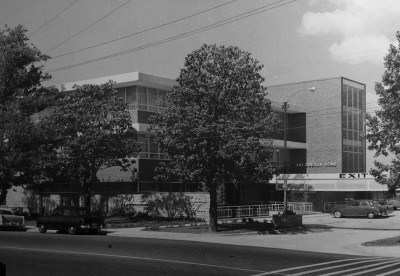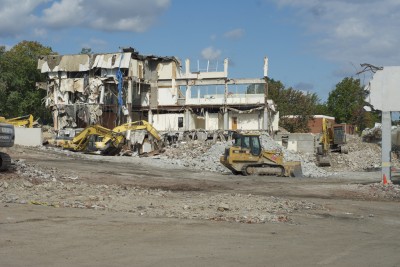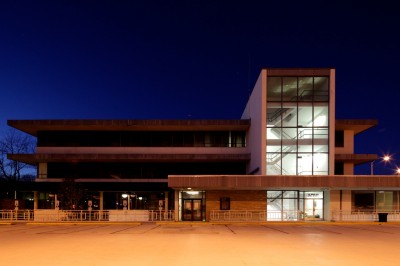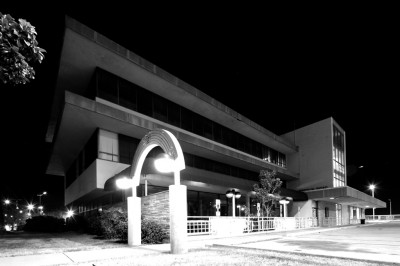Demolished: The Balentine’s Cafeteria Building
Over the course of the past few days, concrete munchers have been hard at work dismantling the building at 410 Oberlin Road in Cameron Village.
Now the building is completely razed, and new construction activity will soon be taking place near the busy intersection of Oberlin Rd. and Clark Ave.

1960s view of Balentine’s Cafeteria, with the “Confederate Room” sign visible on the rock wall. Image from the Lewis Watson Collection, NC Dept. of Archives and History
The Last of a Locally Rare Style
It’s my belief that the Balentine’s Cafeteria building was the last standing example of the prairie style here in Raleigh. This style is characterized as having a flat roof, banded windows grouped in sections, wide overhangs, and an emphasis on a horizontal lines.
This building has a rather modest history: it was once home to Balentine’s Cafeteria, which closed in 1999. Most recently it served as home to the  Cameron Village Library before moving in to their new space, as well as offices. It was designed in 1959 by noted Raleigh Modernist architect Leif Valand:
He attended the Pratt Institute in New York City then practiced architecture in Scarsdale NY. He moved to Raleigh in the late 1940s to design the Cameron Village Shopping Center for developers J. Willie York and R. A. Bryan. Â The vision was massive, even by today’s standards, comprising 65 stores, 112 offices, 566 apartment units, and 100 private homes.
During his heyday, he was one of the most prolific architects in Raleigh. Â With just a few employees, his extensive contacts with Raleigh’s business and real estate elite gained incredible commissions.
While few realize it, Cameron Village was not only the area’s first shopping center, but it was also a massive mixed-use development project unlike any other previously seen in the Southeast.
The Island In a Sea of Concrete
It suffered from a few design flaws, most notably the use of land. The building’s longest side was perpendicular to the main thoroughfare and most of the land was devoted to a surface parking lot on the Oberlin Road side and a parking garage on the other sides. It was a visually interesting brick and river rock island in a sea of parking spaces. Such site plans are generally frowned upon today.
Above demolition video courtesy of Goodnight Raleigh contributor Ian F.G. Dunn.
It was torn down (along with a smaller neighboring structure built around the same time) in order to make way for a new mixed-use project.
The mid-century building has been under-occupied for years and the inside wasn’t anything particularly useful or pretty. While no one could argue that the existing parcel of land was being utilized well, it’s disheartening to see a unique building replaced with something that runs contrary to the character of Cameron Village. That block is comprised mostly of modernist buildings, a few including the Post Office and 401 Oberlin (also facing demolition).
The new project replacing it is a 1920s revivalist style. This was almost certainly the result of the influential residents of Cameron Park whose buy-in was required by the developer. Cameron Park gets a building that looks like their homes, and Cameron Village loses a chunk of its modern character.

Building with only one wall remaining. Image courtesy of Goodnight Raleigh contributor Devin McKim
While I think historic buildings (and for Raleigh in particular its modernist ones) form an important and valuable part of our landscape, I don’t advocate saving every building. However, when we erase some of the unique character from our town, we should ask if what we’re putting in its place is an improvement.
More rental options in this part of town are definitely needed, and in that sense it is an improvement. However, with regard to the visual landscape and how the area will feel afterward, I’m not yet convinced.
You can read more about this building at our sister site, raleigh modern.
UPDATE:
This film, courtesy of A/V Geeks, shows Balentine’s in the 1960s:



 Sign up for the Newsletter
Sign up for the Newsletter
10/20/2011
Sad.
:(
10/20/2011
It is too bad that the old building couldn’t have been kept and the new one added to it using similar architecture.
10/20/2011
So glad to see that eyesore gone for good!
10/21/2011
I for one am truly sorry to see the destruction of this iconic modernist building. I love the horizontal planes intersecting with the vertical four-story stair tower. The 1960 black and white photograph vividly shows how beautiful and graceful this building once was — long before it was all covered over in drab white paint. Yet another major architectural loss for Raleigh.
10/21/2011
I was a bussboy at Ballentine’s when I was in high school right before it closed down for good. I think it was a cool looking building.
10/21/2011
I am sad to see this building gone, not just for its architectural value, but also for what it meant to Raleigh’s history. I am also sad to see that some people don’t value this, but I guess not many folks, either remember an “older Raleigh” or were here in Raleigh, to know that it once had a distinctive charm that no longer exists.
10/24/2011
This is another sad milestone among others. It continues to baffle me that a progressive city like Raleigh is behind the curve on what should be preserved as part of it’s unique architectural landscape. God forbid they go after Dorton Arena next.
10/25/2011
Celeste,
PLEASE do NOT give them ideas!!!
10/26/2011
I’m a Raleigh native, same age as Cameron Village so have grown up witnessing all these changes to CV (among many other places in this city). During my childhood, there was a real scarcity of restaurants in Raleigh so those that were here stand out in one’s memory. I barely remember Balentine’s when it was downtown on Fayetteville Street. It moved to CV when I was around 9 or 10. Balentine’s and the S&W were the two main cafeterias here. What was novel about Balentine’s was that once a week in the Confederate Room downstairs, they had smorgasbord night…what seemed like an endless and quite sophisticated (to me, anyway) spread of food. For X amount of money, you could refill your plate as often as you wanted…a concept unfamiliar to me up until then. Going to eat at Balentine’s on smorgasbord night was a real treat for my sibs and me. Another nice feature was a walled patio/garden with a fountain and other statuary right outside the Confederate Room. Anyhow…even though I hadn’t eaten in Balentine’s in years when it closed, I’m sad to see that this landmark has been reduced to dust.
10/30/2011
The walled patio/garden that raleighgirl mentions was designed by Lewis Clarke, FASLA & ARIBA, and installed by Clarence Steppe. There were several, large speciment trees that were lowered by crane over the parking deck railing down into the lower level with the restaurant. Very exotic move for the time. The patio/garden featured a closed fountain and something rather unique – up lighting mingling amongst the various textures, colors, and heights of the plants. From inside the restaurant, the planting and fountain looked like a magical, gigantic terrarium. So, not only is a Valand building gone, but so is a Lewis Clarke landscape architecture design.
11/02/2011
Thank god, another useless building gone and ready to be replaced by something new and useful. And did you hear? 401 Oberlin was just approved too. Pretty soon a lot of these old buildings will be gone. Good riddance. And all you guys can do is whine about it to each other online. Glad y’all aren’t the ones making the decisions to bring out city forward. It’s the 21st century, not the 19th. Get with the times. If people wanted these things preserved, they would be.
11/02/2011
Hey Jack, why don’t you do us all a favor and go back to where you originally came from. What you fail to see is that Raleigh is not a Boston, or a Jersey City, or whatever the new influx of people are trying to make it. Raleigh was once a small southern city; it had a distinctive charm that is almost all gone. I moved out of Raleigh back in 1984 because I didn’t like the way it was going then. The city I where I was born and grew up in, was disappearing and I didn’t like it. I wanted to live in a place where there was still some semblance of southern charm. I moved to a rural part of western Wake County. And today even that area is transforming daily into a New York satellite. I don’t really have a problem with the people coming into this area, but I do have a problem when they want to destroy those things I value.
11/02/2011
J Spratt:
Our publishing platform informs me that you are the person who has anonymously insulted other readers in the past (“… smells like mayonnaise”), so I want to thank you for choosing a nickname that isn’t offensive.
However, before taking glee at a moment when others are reflecting on the history of an area, you should have read what was written. It is clearly pointed out that rental options are an improvement, and that the Ballentine’s Cafeteria building wasn’t a good use of land. The fate of 401 Oberlin was also stated.
I must also correct you about the desire for preservation, because there are many people that want to preserve old buildings that are worthy and when it makes sense. If no one thought old buildings were important, all of Downtown Raleigh would look like the EIFS-clad genericized utopia you so strongly advocate for.
11/03/2011
Although the trend towards preserving mid-century modern architecture has been introduced to the Triangle and has a loyal and growing group of supporters, it appears that the influence has not been able to take hold in the places where decisions are made. We are proud to say that we have a large number of modern homes & buildings for a southern town, and we as a group like to see them valued for their architectural style and contribution to local history, and as a “living” representation of a certain progressive mindset that existed in Raleigh in the 50’s & 60’s, as a result of the architectural talent that was fostered at NCSU.
Thank goodness for people like George Smart, who has done an award winning and recognized job of organizing and documenting homes and buildings that fall into this category, and were previously not held in such esteem. And thank goodness for John Morris, who has done and outstanding job of documenting their history through photographs and reporting their demise as the population of mid-century modern continues to shrink. At the very least, at least we have that.
11/08/2011
It’s hard to say if the building that comes up after this will be a better building. By most accounts these days, it will not be true as most modern day developers are looking for the quick buck and short term investments. You see it all over this country.
11/08/2011
Reading these comments I’m struck by how many people are sad about 410 Oberlin Road’s destruction, yet there have been few recollections about being inside – two posts about Ballentine’s Cafeteria downstairs and yrowens’s interesting information about the landscape architecture. I’d have expected comments about working or visiting there, or the views, or something specific to the experience of being in the tower as we’ve seen about other notable buildings on Goodnight Raleigh.
I think 410 Oberlin Road suffered two significant strikes against it. First, as with many modern buildings, it’s often hard to feel nostalgic about timeless design. Raleigh Boy’s point is well-taken; the building was more attractive in its original colors. But with so much commercial architecture built as if the developers were hoping to avoid the hassle of future landmark status, it’s no wonder that most of our fond memories are reserved for buildings that we care about as destinations rather than as sculpture.
The other strike against 410 Oberlin Road was more specific. We shouldn’t forget that it was designed at a time when almost any business that mattered was conducted downtown. Orienting the building short-side to Oberlin Road meant that the long side was visible from points south and southeast. I’ve wondered how much of that was an effort to distract potential visitors from the largely African American community in what was once the town of Oberlin beyond the new building to the north and northwest.
While others have written fondly of their time at Ballentine’s Cafeteria, I have to say that, 20 years ago, we found it creepy. At S&W, the clientele was as varied as Raleigh’s population, but the only non-white people we ever saw at Ballentine’s were employees. Why would any member of a minority group choose to patronize an establishment that offered a Confederate Room? Ballentine’s fell off our list pretty early.
11/10/2011
Actually the Ballentine family had a long-standing policy of employing disabled and mentally disabled folks in their cafeteria. They had several longtime employees who otherwise would not have been given a chance at most offices (or other workplaces). I ate there with my Grandfather (as it was his favorite place to eat when he visited from Goldsboro). Johnny and Warren Ballentine were always there on the food line to greet customers and keep things moving. It was a great place and the food was good.
As for the Confederate Room, that was a vestige of the past. They used to sing “Dixie” at NCSU football games too. Perhaps that was before your time.
11/15/2011
Banks Talley, thank you for taking the time to respond to my post and share your recollections of Ballentine’s. Since my last comment was about their lack of non-white patrons, I don’t quite understand your post beginning with “Actually,†unless you really intended to equate racial minorities with “disabled and mentally disabled folks.†I hope not.
It’s clear that you thought Ballentine’s was a great place. Perhaps you didn’t notice the homogeneity of the clientele, or maybe you were more comfortable there than in S&W’s integrated dining areas. It seems that one person’s vestige of the past is another’s discomfiting anomaly.
11/16/2011
I used to eat at Ballentine’s at least once a week with several co-workers, two of whom were African Americans. We worked in the building across the parking lot on the corner of Clark and Oberlin. Saw lots of black folks eating there.
I also attended several banquets in the Confederate Room where many in attendance were black.
I didn’t particularly care for Ballentine’s food, thought K&W was much better.
11/27/2011
I never knew this building when Ballentine’s was open, but I did appreciate the design. I spent a while photographing the structure when I heard it was to be demolished, and I’m now glad to have those memories. Though, as others have said, I still think one of the biggest problems with the design was its orientation–the narrow, undecorated side facing Oberlin was, frankly, boring. And the “back” of the building that one approached when traveling southward was also plain–unfortunately that was the side that faced the majority of Cameron Village. The very attractive south face, the actual front of the building, was always in my experience somewhat hidden by trees and the building next door.
Wouldn’t have made a bit of difference in the end though. Cameron Village does need more residential and mixed-use options lest the whole area die–it’s just highly unfortunate that a fine modernist building will be replaced by neoclassical (and not even *good* neoclassical) cookie-cutter crap.
04/10/2012
Curt:
Ballentine’s was integrated. I am sorry that the one time you ate there, you decided it was not. My point to you was that the Ballentine family was progressive in their thinking and their hiring practices (in a time when not many other people were in Raleigh). Also, they were not racist and they did not ban anyone of color from their dining room. If you find disabled people (mentally, physically or otherwise) “creepy” then perhaps that is your problem.
04/11/2012
Chris M., thank you for describing the problems with the building’s undecorated Oberlin Road and north sides. I didn’t mention those in my comment on 11/08/2011, but I agree with you.
NCSU, funny–I thought Balentine’s food was as good or better than S&W’s, especially the fish. It was the overall experience that felt less and less right. We ate at Balentine’s for dinner and on weekends, so the demographics may have been different from your lunchtime visits. I don’t know about you, but I’ve gone out with coworkers to lots of places that I wouldn’t have chosen personally. I suspect the only way we’ll get the whole picture is if several people of color joined this thread and commented on the issue.
Banks Talley, with all due respect, ongoing use of the name Confederate Room was incompatible with the phrase “progressive thinking†long before the 1990s. And since we’ve never met, it seems you’d know little about my disability status, minority identification, or total Balentine’s patronage. However, your presumptions are quite revealing and I thank you for them.
12/06/2013
Anyone happy with the Oberlin/Clark Ave corner replacements? My opinion, they are as forgettable as most of the ‘mixed use’ construction that seems to be all the rage.
12/06/2013
Did I say forgettable? I meant regrettable.
02/13/2018
did the n and o -and/or the raleigh times have a regular architcture column? some for reason i thought they did. any comments back then or since on the ballantyne cafeteria bldg….its merits, it appearance??